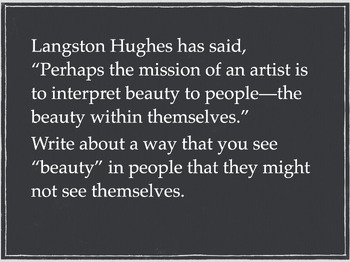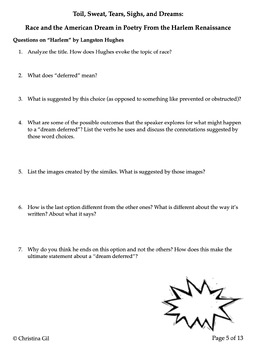Harlem Renaissance Activities: Zora Neale Hurston, Langston Hughes, Art & Music
- Zip
- Google Apps™
- Internet Activities

Description
Tired of superficial resources on the Harlem Renaissance that just go through the motions when it comes to adding diversity to your plans?
So often, in an attempt to study more than dead white males, teachers seek out texts by people of color. But lacking the time or energy to really engage in the research required to plan a great unit, they incorporate a few lackluster biographies and add some short pieces to their plans and leave it at that. The addition of those inane powerpoints, superficial handouts, or boring lectures does little when it comes to helping students to appreciate great art.
But what’s even worse about this kind of good-intentioned planning is that it often does more harm than good as students come to believe that writers of color are less important and less interesting than their white peers. It’s not surprising that they come to this conclusion when their teachers don’t seem to care enough about the work to spend the time fully developing a unit.
If you want your students to fully appreciate the art created in the Harlem Renaissance, and the diversity that truly makes America great, you need a rigorous, well-researched unit that explores the historical roots of the movement, the artistic traditions that fed the art, and the important issues and debates of the time.
***Fifty percent of the proceeds from this resource will be donated to The Conscious Kid, an education, research, and policy organization dedicated to equity and promoting healthy racial identity development in youth.***
The variety of materials, real-life connections, and innovative approaches to the information will keep students engaged and excited about learning. Additionally, the concrete text-based questions and unique sources discourage cheating and encourage students to answer for themselves.
Tackling big questions around race, identity, and art, this unit will not offer easy answers or oversimplified explanations. Instead, it will get your classes thinking deep, reading and analyzing great literature, and enjoying amazing works of art together.
When you teach this innovative unit on the Harlem Renaissance, you will:
- Begin each class period with engaging freewrite prompts designed to get your classes calm, focused, and thinking about the essential questions of the unit.
- Empower your students to engage with the texts independently when they utilize the rigorous but accessible handouts.
- Diversify your plans to meet your students’ needs when you follow the suggestions included in the units.
- Have so much fun with your classes when you explore amazing jazz, blues, and spirituals throughout the unit by utilizing the QR codes or links provided.
- Incorporate multiple learning styles in your planning by including cooperative group work, learning stations, interactive notebook activities, visual art, quick writes, creative writing, and full-class discussions.
- Easily discuss the questions for close reading and discussion when you refer to the extensive answer keys which quote the important passages so their is no guessing on your part.
- Teach your classes to question what they are told and to challenge their assumptions when they examine complicated issues from multiple angles.
- Give assessments that you actually look forward to reading when you choose from the different options including a reading responses, a graded discussion, and a comparative essay.
Want to know how the unit comes together in real life? Click on the preview to see the full unit plans and daily schedule.
Resources included in this unit, at a discount when you buy them together:
* Updated for Google Classroom
*Langston Hughes Poem | Harlem Renaissance | Theme for English B (normally priced at $2.97). In this poem, the speaker is tasked with a vague assignment to write a page about himself. His frustrations with finding the truth through writing are universal, but what this student reveals about the truths of race and his own identity are subtle, complex, and a great addition to your curriculum. You can view the full-priced version of this resource by clicking here.
*Zora Neale Hurston How it Feels to be Colored Me: Discussion, Close Reading (normally priced at $5.97). “How it Feels to be Colored Me” by Zora Neale Hurston is a great choice for engaging your classes in discussions around race, identity, gender, and artistic expression. It’s also a wonderful essay for exploring figurative language and how writers create meaning through comparisons. You can view the full-priced version of this resource by clicking here.
*Langston Hughes Harlem Renaissance Unit: Nonfiction Texts Close Reading (normally priced at $5.97). Exploring themes of what it means to be an African American artist in the twentieth century, this unit on three seminal nonfiction texts will get your students completing close readings of challenging primary sources, discussing complex and important ideas, and exploring some of the great art of the Harlem Renaissance. You can view the full-priced version of this resource by clicking here.
*Langston Hughes "I, Too" and Walt Whitman Paired Texts Poetry Lesson (normally priced at $1.97). In "I Hear America Singing" by Walt Whitman and "I, Too" by Langston Hughes, the two poets present parallel views of the American experience. Whitman’s poem is joyous and celebratory; Hughes’ poem is more skeptical, but it is not without hope. You can view the full-priced version of this resource by clicking here.
*Langston Hughes "Let America Be America Again" Poetry Analysis Lesson (nornally priced at $2.97). This poem expresses disillusionment as well as hope. While Hughes points out all the problems, all the ways that less powerful groups suffer in the United States, he also has hope that the people will one day rise up and make the country great, fulfilling its potential in a way that they have not done yet. You can view the full-priced version of this resource by clicking here.
*Claude McKay Poem: If We Must Die | Harlem Renaissance Poetry Unit (normally priced at $2.97). What is the best way for people to maintain their dignity in the face of racism, oppression, and brutality? Written after the horrific events of the Red Summer of 1919, Claude McKay’s timeless poem “If We Must Die” attempts to answer that important question. This classic of the Harlem Renaissance is also a great poem to explore issues of the Black Lives Matter movement. You can view the full-priced version of this resource by clicking here.
Langston Hughes "A Dream Deferred" Paired Text: Nonfiction, Photographs | Harlem (normally priced at $4.97). In this unique mini unit, your students will examine the idea of "Harlem" by analyzing a photographic essay about a Harlem gang leader from the 1940s, including contemporary criticism of that article. They will also read, analyze, and discuss the iconic poem "Harlem" by Langston Hughes and a satirical essay about Harlem. You can view the full-priced version of this resource by clicking here.
*Harlem Renaissance Poetry Unit | Paired Texts with Langston Hughes (normally priced at $3.99). These questions on "Harlem" (also known as "Dreams" or "A Dream Deferred") by Langston Hughes, “Sonnet to a Negro in Harlem,” by Helene Johnson, and "We Were the Mask" by Paul Laurence Dunbar will get your students exploring themes of race, culture, and heritage. You can view the full-priced version of this resource by clicking here.
Zora Neale Hurston, Harlem Renaissance Short Story Unit Plan (normally priced at $5.97). “John Redding Goes to Sea” was Hurston’s first published story. The tale of a man who longs to reach the horizon is a great story for discussing dreams and what keeps us from achieving them. The main character wants to leave his small town and travel the world, but just like the wooden boats that he plays with as a child, he gets caught up in the weeds and prevented from reaching his destination. You can view the full-priced version of this resource by clicking here.
*Zora Neale Hurston "Sweat" | Harlem Renaissance Short Story Unit Plan (normally priced at $4.97). This fascinating mini unit will take your students through recordings of Zora Neale Hurston singing songs she learned through her anthropological research during the Great Depression, a brief exploration of African American spirituals, close reading of the short story, analysis of the masterful figurative language, an analysis of biblical allusions in the text, and dynamic discussions on the bigger questions and themes of the story. You can view the full-priced version of this resource by clicking here.
Close Reading Strategies, Techniques, & Tips: A Practical Guide for High School (normally priced at $3.97). Honed over 16 years of teaching high school English, including AP literature, this guide is different from all of the other close reading handouts because it explains the process in a way that actually makes sense to students—and teachers. The explanations and handouts included in this resource will help you and your classes make sense of the close reading process so that your students will be able to take the lessons learned and apply them to any text. You can view the full-priced version of this resource by clicking here.
Close Reading for Any Text: Differentiated Reading Response Journal Prompts (normally priced at $5.97). This guide to reading response reaction journals based on quote analysis and close reading will get your students reading, analyzing, and writing about literature on their own. I have been teaching with reading responses for eleven years, and this guide includes what you need to teach your students to think independently without having to read and grade every single thing they write. You can view the full-priced version of this resource by clicking here.
*Poetry Unit: Poetry Activities | Literary Devices | Poetry Writing | Handouts (normally priced at $7.97). Honed over sixteen years of teaching, the resources in this unit will help your students to more fully appreciate how literary devices create meaning in texts. This resource includes a handout on devices, a quick quiz to check understanding, and a presentation assignment for students. You can view the full-priced version of this resource by clicking here.
Bonus Resources not Included in the Bundled Resources:
A full-day activity for exploring the music of the Harlem Renaissance; includes no-prep handouts with QR codes and reflection questions.
*A lesson plan on the TED Talk “The Great Migration and the Power of a Single Decision” which will help students understand the importance of the Great Migration on the art of the time; includes questions on the talk and an extensive answer key.
Texts and Sources Covered in the Unit:
“Theme for English B,” a poem by Langston Hughes
“How it Feels to Be Colored Me,” an essay by Zora Neale Hurston
Jazz and Blues music recordings by Billie Holiday, Chick Webb, Louis Armstrong, Duke Ellington, Bessie Smith, Fats Walker, Cab Calloway, Jelly Roll Morton, Ethel Walters, Miles Davis, and John Coltrane
“The Great Migration and the Power of a Single Decision,” a TED Talk by Isabel Wilkerson
“The Negro Artist and the Racial Mountain,” an essay by Langston Hughes
“I Hear America Singing,” a poem by Walt Whitman
“I, Too,” a poem by Langston Hughes
“Let America Be America,” a poem by Langston Hughes
“If We Must Die,” a poem by Claude McKay
“Harlem,” a poem by Langston Hughes
“The Whites Invade Harlem,” a satirical essay by Levi C. Hubert
“Harlem Gang Leader,” a photo essay by Gordon Park
“Sonnet to a Negro in Harlem,” a poem by Helene Johnson
“We Wear the Mask,” a poem by Paul Dunbar
“John Redding Goes to Sea,” a short story by Zora Neale Hurston
“Sweat,” a short story by Zora Neale Hurston





